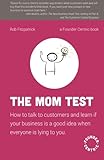1. Quality over quantity. "Talk to users" works best when you have a well-defined market or ICP. Talking to 10 users in your ultra-specific niche is way better than talking to 100 users across multiple niches.
2. Your script matters a lot. Asking leading questions will get you results you can't trust. I think The Mom Test (https://www.amazon.com/Mom-Test-customers-business-everyone/...) is a great intro on this topic.
3. Talk to enough users that you start being able to predict their answers. If you are running interviews and still getting new/surprising answers to your questions, then it means you either haven't spoken to enough people or have a poorly defined ICP... If you need #s, I generally find that after 10 interviews in a very focused ICP, you should start seeing patterns.
Finally, there is an exception to every rule. Your specific market might need more interviews, or you might have such a good insight that you skip formal interviewing all together.
https://www.amazon.com/Mom-Test-customers-business-everyone/...
https://www.amazon.com/Mom-Test-customers-business-everyone/...
The first one is The Mom Test[0] which has already been mentioned here. But it's more about customer interviews which you usually do before you even start doing something.
And the second one is Traction[1] written by Gabriel Weinberg founder of DuckDuckGo and Justin Mares. This book is highly relevant for a situation where you already have something and need to find your first customers. The great thing about this book is that it gives you a framework and a finite list of strategies that you can prioritise and execute one by one until you get traction.
0: https://www.amazon.co.uk/Mom-Test-customers-business-everyon...
1: https://www.amazon.co.uk/Traction-Startup-Achieve-Explosive-...
You shouldn't ask your mom about the viability of an idea because she will be biased towards thinking good things about you (and your ideas). Similarly (sort of...), Hacker News will be biased towards wanting your product and not say anything bad about it.
https://www.amazon.com/Mom-Test-customers-business-everyone/...
"Create a solution to somebody else’s problem, where that problem sits at the intersection of being genuinely interesting / meaningful to you and being something that you are reasonably capable of addressing."
I also want to second his book recommendation [The Mom Test](https://www.amazon.com/Mom-Test-customers-business-everyone/...). It's really short and will save you a lot of time building things nobody will pay for.
A book recommended by YC's Aaron Epstein is The Mom Test[0]. The first 50-60% of the book is dedicated to how to discover problems with end clients/users that are worth tackling.
I have used the techniques personally and it's great to see what users say is a huge problem vs a problem they're willing to pay for.
It is easy to get stuck in a self-fulfilling trap that a user complains is a big problem. I recently spoke with a customer:
- "What's your biggest problem?" (book says this question is a no no)
- He replies, "If I sell 3 cars at the same time, I'm out of available float (cash) while I wait for those deals to close. This is a HUGE problem for me!"
- "How do you solve this today?" I ask.
- "I have other, larger car sales company who will lend me money at XX rates."
Right there, it's a solved problem. The end user figured out their own way. Turns out other smaller dealers like him rely on large trade line companies.
The only way I could complete is either on lower cost of financing or speed. At which point, for me, it's not a problem worth solving. The problem isn't so big for him where he's willing to throw cash at me for it.
Talk to users.
[0] https://www.amazon.com/Mom-Test-customers-business-everyone-...
* Strategy #1: Charge more. patio11 has been shouting this from the rooftops for years, but it didn't sink in until after I started Indie Hackers[0]. If you charge something like $300/customer instead of $5/customer, you can get to profitability with something like 50 phone calls rather than years of slogging. It's still hard, but it's way faster.
* Strategy #2: Brian Balfour's four fits model[1]. It's not enough to think about the product. You also need to think about the market, distribution channels, and pricing, and how each of these four things fit together. I imagine them as four wheels on a car. It's better to have 4 mediocre wheels than 3 great ones and a flat.
* Book: The Mom Test.[2] Amazing book about how to talk to customers to research your ideas without being misled, which is a step I've stumbled on before.
* Tool: Notion. I just discovered it recently. I use it for all my docs and planning.
[0] https://www.indiehackers.com - my latest business, and the one that actually worked
[1] https://brianbalfour.com/four-fits-growth-framework
[2] https://www.amazon.com/Mom-Test-customers-business-everyone/...
[0] https://www.amazon.com/Mom-Test-customers-business-everyone-...
https://www.amazon.com/Mom-Test-customers-business-everyone/...
The first few pages blew my mind. It was a great read all the way through.
Damn, and here I thought being based in SEA provides for a veil of secrecy. Never thought we'd be out in the woodworks so early.
That's a good idea to reach out to others, I use 'The Mom Test' when validating customer problems - http://www.amazon.co.uk/The-Mom-Test-customers-business/dp/1...
It's on Amazon[2] as a paperback via createspace[3] print-on-demand and as an ebook via gumroad[4]. Both platforms have been great.
It took 10 months part-time from first words on paper until the finished book was in people's hands. Editing was the most painful part and took 3 months. I did the first draft on paper, and the revising in scrivener[5], which also handles exporting to all the ebook formats.
I made illustrations for it, but left them out since the layout was taking more time than it was worth and I wanted to ship it.
Incidentally, I'm also working on a book landing page generator called heylookabook[6] . I'm building in some of the marketing best-practices that I learned from working on my own, so it's there if it's helpful!
[1] http://momtestbook.com [2] http://www.amazon.com/The-Mom-Test-customers-business/dp/149... [3] http://createspace.com [4] http://gum.co/momtest [5] http://www.literatureandlatte.com/scrivener.php [6] http://heylookabook.com


https://www.amazon.co.uk/Mom-Test-customers-business-everyon...